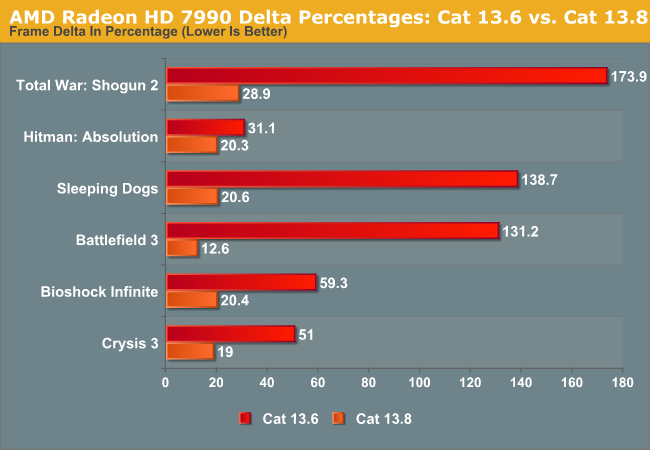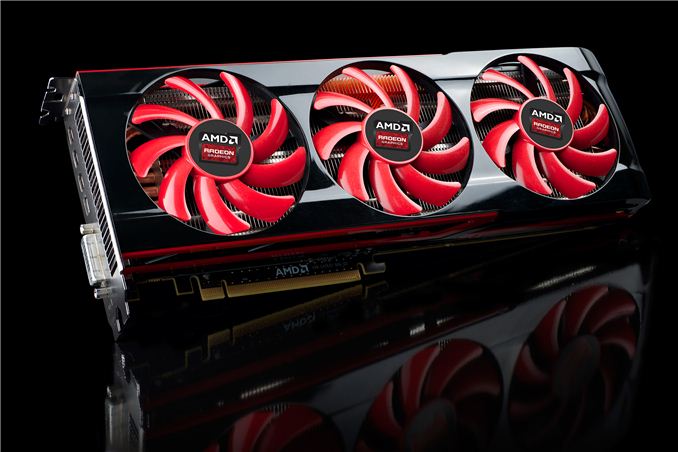AMD Frame Pacing Explored: Catalyst 13.8 Brings Consistency to Crossfire
by Ryan Smith on August 1, 2013 2:00 PM ESTFinal Words
Bringing things to a close, today’s driver release isn’t about any grand revelations for AMD, but rather about AMD following through on their plans and commitments to improve frame time consistency on their products. We’ve seen AMD get their house in order with respect to single-GPU cards earlier this year, and now the same is starting to happen for multi-GPU setups.
To be clear here AMD’s initial situation should never have happened. AMD should have been doing the appropriate competitive analysis from the start, never letting themselves fall behind like this. But we aren’t in the business of berating companies that make an honest effort to improve their products like AMD is doing, so while AMD could have done better in the past they are finally making the right moves in the present, and it’s the present that’s going to be the most important for AMD’s customers.
So what does AMD’s present look like? Quite frankly, it looks a lot better than it did yesterday. AMD set out to greatly improve on their frame pacing situation on their Crossfire setups and they have delivered just that. With just one driver revision we have seen the Radeon HD 7990’s frame pacing go from laughable to acceptable; delta percentages of over 100% have been reduced to 20% or lower in 5 of the 6 games we’ve tested. For those sensitive to micro-stutter and other matters of consistency the difference is at times going to be staggering. At the most basic level, AMD has achieved their objectives.
With that said, there’s still room for improvement, and this goes for both functionality and further improvements in frame consistency. AMD’s triage-like approach means that D3D9, OpenGL, and most importantly Eyefinity are still not capable of using frame metering. These will be covered in future phases of AMD’s rollout of their frame pacing technology, and they can’t come soon enough, but for the time being these are limitations that need to be kept in mind.

Similarly while AMD’s frame pacing has improved to the point where we find it acceptable, 20% deltas are still generally twice that of NVIDIA’s GeForce GTX 690, never mind the extreme consistency single-GPU setups offer. We never realistically expected AMD to match NVIDIA’s frame interval consistency overnight, but in time it would be nice to see them get close, and for both parties to further improve beyond that.
Moving on, while today’s driver release is primarily one part of AMD’s longer term plan to deal with frame interval consistency, AMD is trying hard to also use this moment as something of a second launch for the Radeon HD 7990. With the 7990 launching in April it had the poor timing of arriving shortly after the multi-GPU frame pacing issue came to a head, which is something that has hobbled the card since its launch. In terms of absolute performance (average frame rates) things have changed very little since the launch of the 7990 so we’re not going to get into the matter of performance.
What has changed since then for the 7990 is first and foremost its frame pacing improvements as we’ve seen today. To be very clear here the GTX 690 is still the better card for those users heavily concerned about consistency, but AMD’s improvements have brought the 7990 to the point where we find its frame consistency generally acceptable. This isn’t a rousing recommendation nor is it meant to be, but it’s a reflection of the fact that AMD has brought their consistency to the point where pairing up multiple Tahiti GPUs as is done in the 7990 is no longer fraught with the frame pacing problems it once was. For most users I believe we’re to the point where the consistency differences are greater on paper than they are on the eyes, but of course that is going to depend on the visual acuity of the user.

Moving on, the other thing that has changed for AMD is pricing and competitive positioning. Officially AMD hasn’t cut the price on the 7990, but the fact that XFX is now offering a reference 7990 for $799 after rebate is not a coincidence. With AMD’s Level Up with Never Settle Reloaded promotion still running, AMD is making a clear play for the value segment right now. I don’t believe it’s where AMD would like to be, but there’s no arguing that it’s effective. For users who have a reasonable level of faith in Crossfire scaling and are satisfied with AMD’s frame pacing improvements, a $799 7990 is a very good deal at the moment.
With that in mind, we do want to reiterate that our editorial position here on AFR setups isn’t changing. We still favor strong single-GPU setups over weaker multi-GPU setups, but this is a matter of valuing the lack of AFR profile requirements, coupled with the tendency for newly launched games to have immature AFR profiling, and of course the general consistency issues we’ve covered today. AFR is still the only way to further improve performance once the single-GPU route has been exhausted, and in AMD’s case it’s the only way to exceed the performance of a 7970 GHz Edition, so it does have its place.
Ultimately we have to give AMD the kudos they deserve. They have come forward about their issues, set out a plan to fix them, and have begun delivering on those plans. There’s still room for further improvement within AMD’s drivers, so AMD’s job is far from done, but today they have taken the first step needed to settle the frame pacing problems that have been dogging their products.










102 Comments
View All Comments
chizow - Wednesday, August 7, 2013 - link
There was discussions of microstutter on various forums associated with multi-GPU, but PCGH was the first site to publish it's findings in detail with both video evidence and hard data. From what I remember, they were the first to develop the methodology of using FRAPs frametimes and graphing the subsequent results to illustrate microstutter.BrightCandle - Friday, August 2, 2013 - link
One of the most shocking revelations to me is that AMDs quality assurance did not include checking the output of their cards frame by frame. I had always assumed that both NVidia and AMD had HDMI/DVI/VGA recorders that allowed them to capture the output of their cards so they could check them pixel by pixel, frame by frame and presumably check they were correct automatically.Such a technology would clearly have shown the problem immediately. I am stunned that these companies don't do that. Even FCAT is a blatantly blunt tool as it doesn't say anything about the contents of the frames. We still don't have any way to measure end to end latency for comparison either. All in all there is much to left to do and I am not confident that either company is testing these products well, its just I couldn't believe that AMD wasn't testing theirs for consistency (it was obvious when you played it something was wrong) at all.
krutou - Friday, August 2, 2013 - link
AMD is in the business of being the best performance per price entry in every market segment. Technology and quality come second.How often does AMD introduce and/or develop technologies for their graphics cards? The only two that come to mind are Eyefinity and TressFX (100 times more overhyped than PhysX).
Death666Angel - Saturday, August 3, 2013 - link
I think ATI had tessellation in their old DX8 chips. nVidia bought PhysX, so that shouldn't count. But I don't really see how having exclusive technology usable by a single GPU vendor is anything good. We need standardization and everybody having access to the same technologies (albeit with different performance deltas). Look at the gimmicky state of PhysX and imagine what it could be if nVidia would allow it to be fully utilized by CPUs and AMD GPUs?krutou - Saturday, August 3, 2013 - link
Because OpenCl and TressFX are doing so well right?bigboxes - Sunday, August 4, 2013 - link
March on, fanboi.JamesWoods - Sunday, August 4, 2013 - link
If you think that is all AMD/ATI has ever done for graphics then you sir, are ignorant. I was going to use a more degrading word there and thought better of it.Will Robinson - Friday, August 2, 2013 - link
LOL...what a load of tosh."NVDA had to take them by the hand"?
You and Wreckage ought to post in green text.
chizow - Friday, August 2, 2013 - link
Agree with pretty much of all of this, although I would direct a lot of the blame on AMD's most loyal, enthusiastic supporters as well. Every time microstutter was mentioned and identified as being worst with AMD solutions, AMD's biggest fans would get hyperdefensive about it. If those most likely to have a problem were too busy denying any problem existed, it really should be no surprise it was never fixed.And this is the result. Years of denial and broken CF, finally fixed as a result of the scrutiny from the press and laughter of Nvidia fans which brought this to a head and forced AMD to take a closer look and formulate a solution.
EJS1980 - Friday, August 2, 2013 - link
"Truth favors not one side."